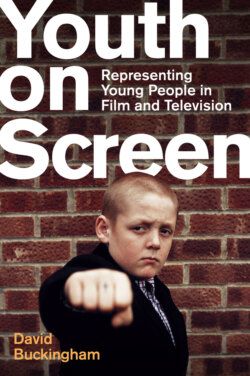Читать книгу Youth on Screen - David Buckingham - Страница 6
1 Introduction
ОглавлениеAs I was completing the outline of this book in late 2019, a news story about youth and screens briefly hit the headlines. ‘Police attacked during machete brawl at Birmingham cinema,’ it proclaimed.1 Apparently, a group of Asian youth – possibly queuing to attend a new British film called Blue Story – had been involved in a fight in the foyer of the Star City multiplex at around 5.30 one November afternoon. About 100 people were involved, several police officers were injured, and five young people were arrested. The cinema chain Vue promptly withdrew Blue Story from its theatres across the country, although it eventually relented, and the film went on to enjoy reasonable box-office returns.
Directed by the young Black British director Andrew Onwubolu (also known as Rapman), Blue Story is set in the mean streets of Peckham in South London. It focuses on two young African-Caribbean men and their steadily deepening involvement in drug-related gang violence. The film was Onwubolu’s first feature and was a developed version of a short drama series he first created for YouTube in 2014; his subsequent YouTube hit Shiro’s Story (2018), reportedly shot for just £3,000, had gained around 8 million views for each of its three episodes. While Blue Story was financed by the BBC and eventually picked up by Paramount for global distribution, its origins reflect the changing circumstances of media production in the so-called digital age.
Nevertheless, there is also something curiously old-fashioned going on here. The ‘brawl’ surrounding Blue Story recalls the rioting in UK cinemas that accompanied the release of one of the oldest films I’ll consider in this book, Blackboard Jungle, almost sixty-five years earlier. In both cases, the violence resulted in outraged newspaper headlines and swift action from the authorities. In this instance, there was no evidence that the young people involved had actually seen the film, or that they even intended to do so. For his part, Onwubolu condemned the response as ‘racist’, while other commentators invoked the rather predictable charge of ‘moral panic’.
Furthermore, like Blackboard Jungle, Blue Story is essentially a cautionary tale, and a fairly traditional one: the two well-meaning heroes are driven by love, friendship and loyalty, even as they are pulled into the inevitable spiral of gang violence by ill-intentioned older members. Some critics praised the film for its authenticity and gritty realism, although it also uses rap to comment on the action in a much more distanced way. Yet the film is far from being a celebration of youthful violence, and it can hardly be said to glamorize the lives it portrays.
Debates about the influence of the media on young people, and the representation of youth on screen, take different forms at different times and in different locations. These may seem like perennial issues, but they are also historically specific: youth in the USA in 1955 is not the same thing as youth in the UK in 2019. Nevertheless, youth has always had a unique and ambiguous status in film and television. Right from the origins of cinema, countless films and television dramas have offered sensational and seductive representations of young people and their lives. And young people have also been an increasingly significant and lucrative audience, with considerable amounts of disposable income.
Yet, to state the obvious, representations of youth in film and television are rarely produced by young people themselves. Of course, young people do make their own films; and, while there is a long (and partly hidden) history here, the advent of digital media has significantly extended the opportunities for young film-makers. Even so, almost all commercially produced movies about young people – the films that reach cinemas, commercial streaming services and broadcast television – are produced by adults. The same is true for ‘youth television’, and indeed for most novels about youth.
Furthermore, these representations are addressed and marketed not only to young people themselves but also to adult audiences. For young people, particular movies or television dramas might appear to sustain subversive desires – desires to challenge or escape adult authority, to indulge in illicit pleasures, or to enjoy forms of power that are rarely possible in real life. For adults, they may provide retrospective fantasies about ‘the way we were’, although they sometimes seek to question or disrupt any easy nostalgia: they may remind us of what we have lost, but also of places and time periods that we might not actually want to revisit. As this implies, representations of youth on screen may tell us as much (or more) about adulthood as they do about youth itself.
